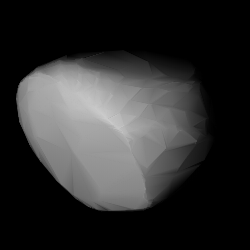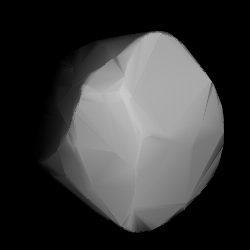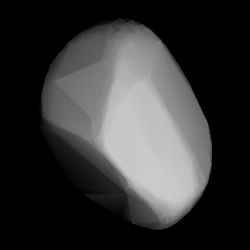Related Research Articles

1036 Ganymed, provisional designation 1924 TD, is a stony asteroid on a highly eccentric orbit, classified as a near-Earth object of the Amor group. It was discovered by German astronomer Walter Baade at the Bergedorf Observatory in Hamburg on 23 October 1924, and named after Ganymede from Greek mythology. With a diameter of approximately 35 kilometers, Ganymed is the largest of all near-Earth objects but does not cross Earth's orbit. The S-type asteroid has a rotation period of 10.3 hours. In October 2024, it is predicted to approach Earth at a distance of 56,000,000 km; 35,000,000 mi (0.374097 AU).

35 Leukothea is a large, dark asteroid from the asteroid belt. It was discovered by German astronomer Karl Theodor Robert Luther on April 19, 1855, and named after Leukothea, a sea goddess in Greek mythology. Its historical symbol was a pharos ; it is in the pipeline for Unicode 17.0 as U+1CED0 .

40 Harmonia is a large main-belt asteroid. It was discovered by German-French astronomer Hermann Goldschmidt on March 31, 1856, and named after Harmonia, the Greek goddess of harmony. The name was chosen to mark the end of the Crimean War.

96 Aegle is a carbonaceous asteroid and the namesake of the Aegle family located in the outer regions of the asteroid belt, approximately 170 kilometers in diameter. It was discovered on 17 February 1868, by French astronomer Jérôme Coggia at the Marseille Observatory in southeastern France. The rare T-type asteroid has a rotation period of 13.8 hours and has been observed several times during occultation events. It was named after Aegle ("brightness"), one of the Hesperides from Greek mythology.

154 Bertha is a main-belt asteroid. It was discovered by the French brothers Paul Henry and Prosper Henry on 4 November 1875, but the credit for the discovery was given to Prosper. It is probably named after Berthe Martin-Flammarion, sister of the astronomer Camille Flammarion.

155 Scylla is a main belt asteroid. It was discovered by Austrian astronomer Johann Palisa at the Austrian Naval Observatory on 8 November 1875, and named after the monster Scylla in Greek mythology. Two weeks after its discovery this asteroid became lost and was not recovered for 95 years. It was finally found by Paul Wild of Berne, Switzerland with the aid of an ephemeris created in 1970 by Conrad M. Bardwell at Cincinnati Observatory.

157 Dejanira is a main belt asteroid that was discovered by Alphonse Borrelly on 1 December 1875, and named after the warlike princess Deianira in Greek mythology. The Dejanira family of asteroids is named after it.

375 Ursula, provisional designation 1893 AL, is a dark asteroid and parent body of the Ursula family from the outer regions of the asteroid belt. It is one of the largest asteroids with a diameter of approximately 200 kilometers. It was discovered on 18 September 1893, by French astronomer Auguste Charlois at Nice Observatory in France. The referent of the asteroids's name is unknown.
627 Charis is an asteroid and the parent body of the Charis family, located in the outer regions of the asteroid belt, approximately 49 kilometers in diameter. It was discovered on 4 March 1907, by German astronomer August Kopff at the Heidelberg-Königstuhl State Observatory in southwest Germany. The asteroid was named after the Greek goddess Charis, a name which may have been inspired by the asteroid's provisional designation 1907 XS.
730 Athanasia is a background asteroid from the inner regions of the asteroid belt, approximately 4.5 kilometers in diameter. It was discovered by Austrian astronomer Johann Palisa at the Vienna Observatory on 10 April 1912. The presumed stony S-type asteroid has a rotation period of 5.7 hours and is likely very elongated in shape. It was named Athanasia, the Greek word for "immortality".
745 Mauritia is a dark background asteroid from the outer regions of the asteroid belt, approximately 24 kilometers in diameter. It was discovered on 1 March 1913, by German astronomer Franz Kaiser at the Heidelberg-Königstuhl State Observatory in Germany. The presumed carbonaceous C-type asteroid has a rotation period of 9.9 hours. It was named after Saint Maurice, patron of the Saint Mauritius church in the city of Wiesbaden, where the discoverer was born.
821 Fanny is a dark background asteroid and slow rotator from the central regions of the asteroid belt. It was discovered on 31 March 1916, by German astronomer Max Wolf at the Heidelberg-Königstuhl State Observatory in southwest Germany. The carbonaceous C-type asteroid (Ch) has an exceptionally long rotation period of 236.6 hours and measures approximately 29 kilometers in diameter. Any reference of the asteroid's name to a person is unknown.
826 Henrika is a background asteroid from the central regions of the asteroid belt. It was discovered by German astronomer Max Wolf at the Heidelberg-Königstuhl State Observatory on 28 April 1916. The carbonaceous C-type asteroid has a rotation period of 5.98 hours and measures approximately 21 kilometers in diameter. Any reference to the origin of the asteroid's name is unknown.
924 Toni is a large background asteroid, approximately 80 kilometers in diameter, from the outer regions of the asteroid belt. It was discovered on 20 October 1919, by German astronomer Karl Reinmuth at the Heidelberg-Königstuhl State Observatory. The X-type asteroid has a rotation period of 19.4 hours. It was named "Toni", a common German female name unrelated to the discoverer's contemporaries, that was taken from the almanac Lahrer Hinkender Bote.
989 Schwassmannia is a stony background asteroid and a slow rotator from the central regions of the asteroid belt, approximately 12.5 kilometers in diameter. It was discovered on 18 November 1922, by astronomer Friedrich Karl Arnold Schwassmann at the Bergedorf Observatory in Hamburg, Germany. The bright S/T-type asteroid has a long rotation period of 107.9 hours. It was named after the discoverer himself.

1061 Paeonia, provisional designation 1925 TB, is a carbonaceous background asteroid from the outer regions of the asteroid belt, approximately 19 km (12 mi) in diameter. It was discovered on 10 October 1925, by German astronomer Karl Reinmuth at the Heidelberg-Königstuhl State Observatory in Heidelberg, Germany. The C-type asteroid has a rotation period of 8 hours and is likely very elongated. It was named after the flowering plant Paeonia, commonly known as peony.
1470 Carla, provisional designation 1938 SD, is a carbonaceous asteroid from the outer regions of the asteroid belt, approximately 35 kilometers in diameter.

1218 Aster, provisional designation 1932 BJ, is a bright asteroid from the inner regions of the asteroid belt, approximately 5.5 kilometers in diameter. Discovered by Karl Reinmuth in 1932, it was later named after the flowering plant Aster.
1479 Inkeri, provisional designation 1938 DE, is an asteroid from the central regions of the asteroid belt. It is an exceptionally slow rotator, suspected tumbler and measures approximately 19 kilometers in diameter. It was discovered on 16 February 1938, by Finnish astronomer Yrjö Väisälä at the Iso-Heikkilä Observatory in Turku, Finland. "Inkeri" is the name of two of the discoverer's younger relatives as well as the local name of the former Finnish province of Ingria.
1990 Pilcher, provisional designation 1956 EE, is a stony background asteroid from the Florian region of the inner asteroid belt, approximately 7 kilometers in diameter. It was discovered on 9 March 1956, by German astronomer Karl Reinmuth at the Heidelberg-Königstuhl State Observatory in Heidelberg, Germany. In 1982, it was named by the MPC for American physicist and photometrist Frederick Pilcher. The S-type asteroid has a short rotation period of 2.8 hours.
References
- 1 2 "Minor Planet Lightcurve Data (data collected by ASLC member, Frederick Pilcher)". ASLC – Astronomical Society of Las Cruces. Retrieved 20 March 2018.
- 1 2 Schmadel, Lutz D. (2007). "(1990) Pilcher". Dictionary of Minor Planet Names – (1990) Pilcher. Springer Berlin Heidelberg. p. 161. doi:10.1007/978-3-540-29925-7_1991. ISBN 978-3-540-00238-3.
- ↑ "1990 Pilcher (1956 EE)" (PDF). Illinois College (PDF). p. 203. Retrieved 20 March 2018.
FREDERICK PILCHER, Associate Professor of Physics (1962, 2005) B.S., Washburn, University; M.S., University of Kansas
- ↑ "The Strolling Astronomer – (Minor Planets)" (PDF). ALPO – Association of Lunar and Planetary Observers (PDF). 2001. p. 8. ISSN 0039-2502 . Retrieved 20 March 2018.
- ↑ "About the ASLC". ASLC – Astronomical Society of Las Cruces. Retrieved 20 March 2018.
- ↑ "MPC/MPO/MPS Archive". Minor Planet Center. Retrieved 20 March 2018.